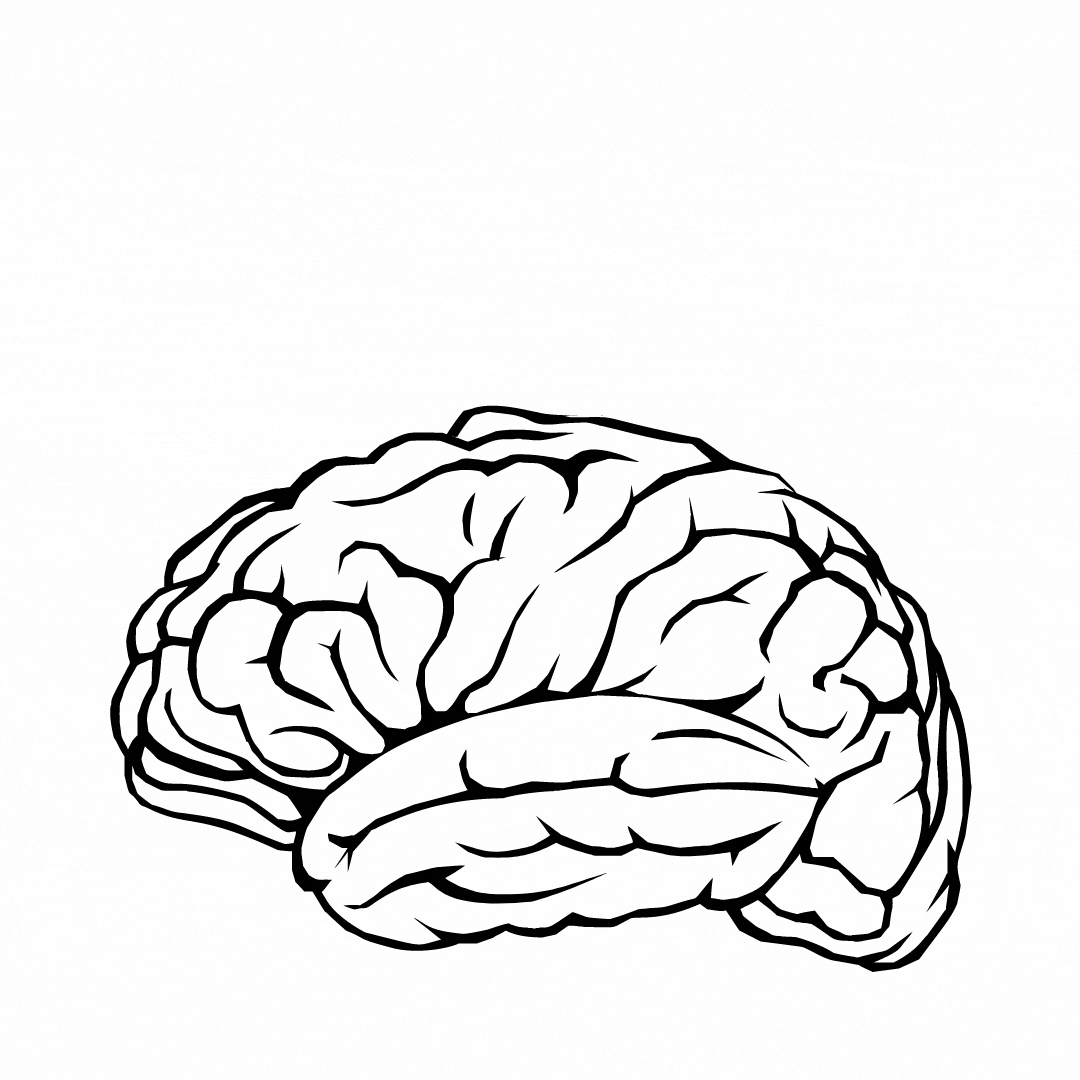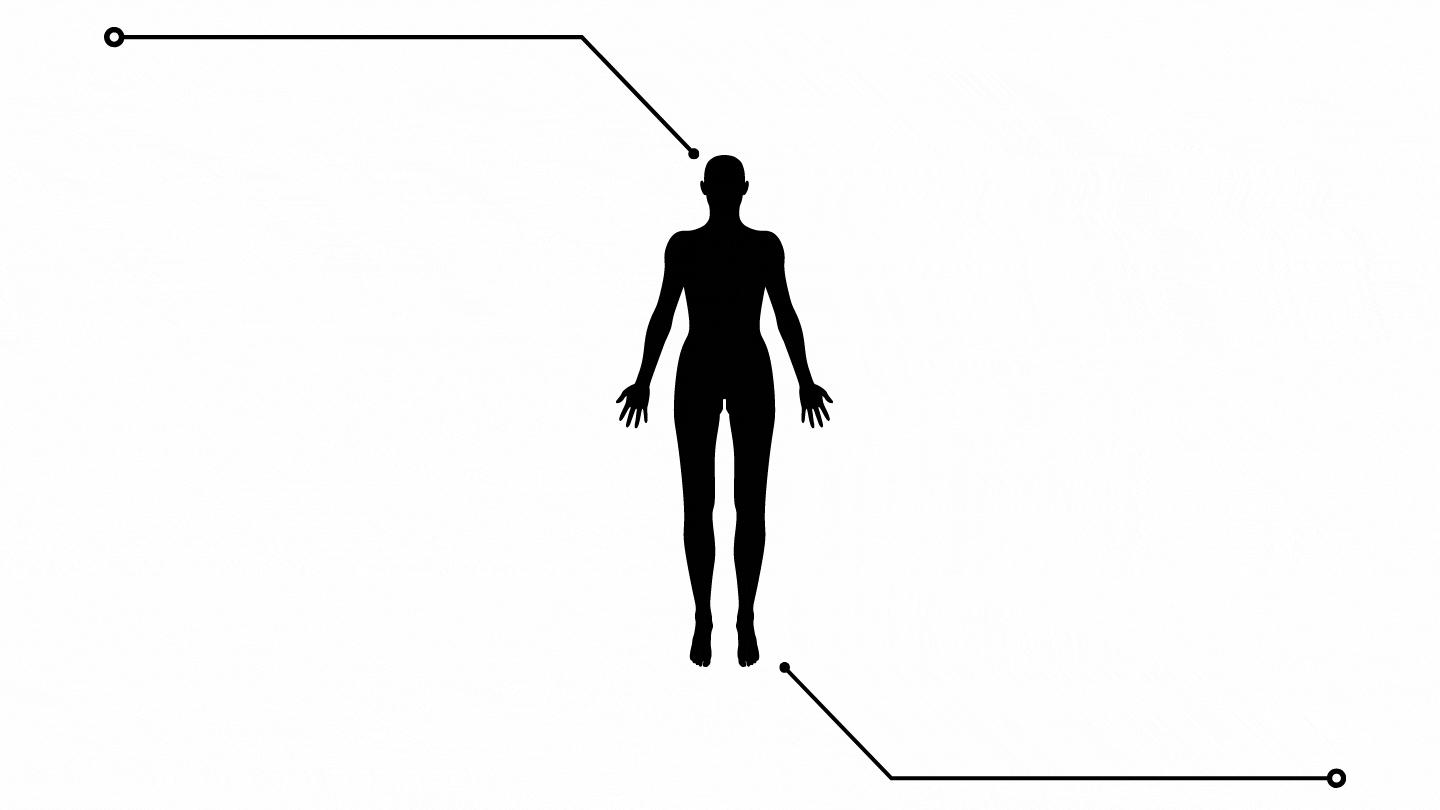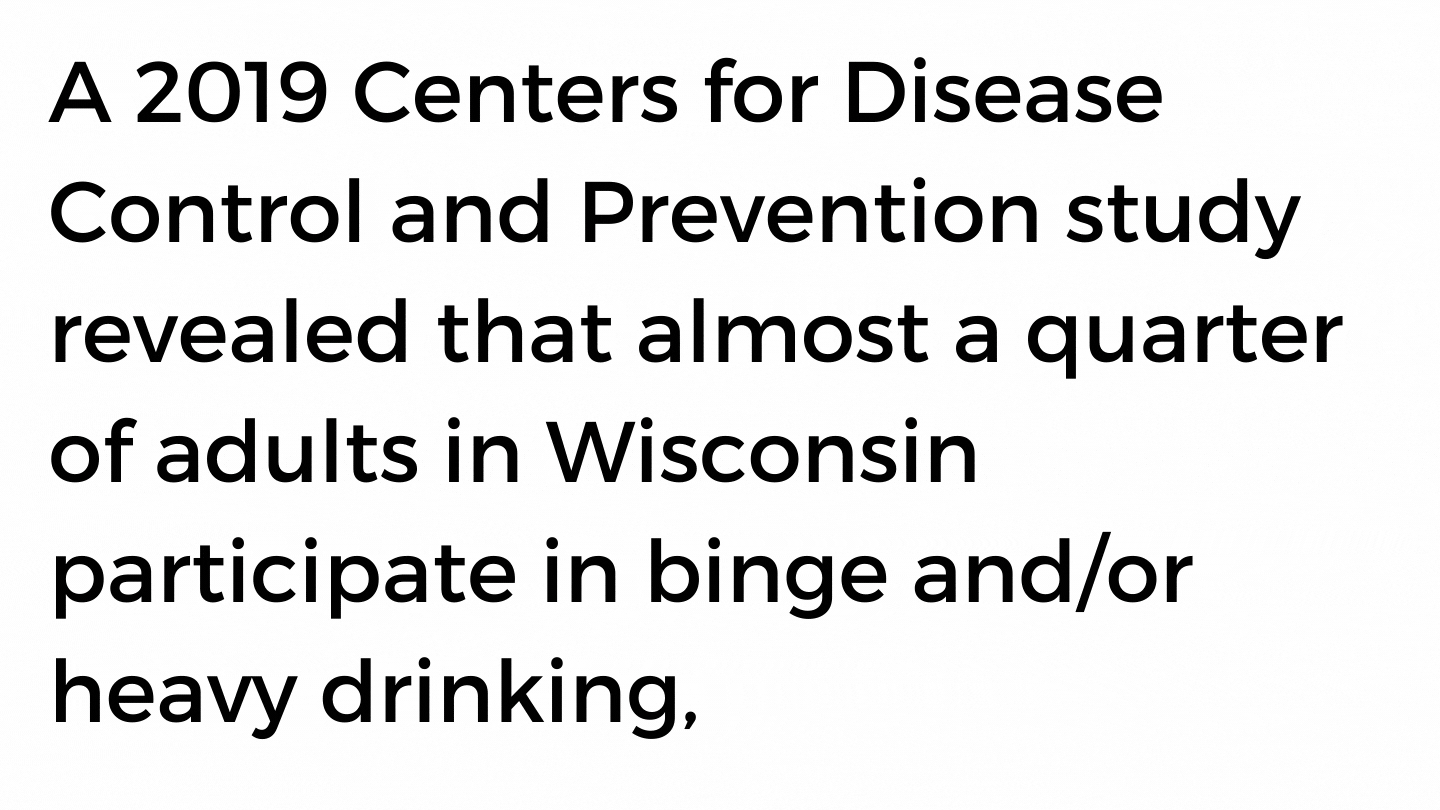Blackout: The dark side of the drunkest state in America
Elea Levin
Cailyn Schiltz
Tamia Fowlkes
“We’ve incorporated [alcohol] into all these different rituals and ceremonies, and it’s kind of ingrained in some of our society. But it doesn’t necessarily mean it’s good for you. It definitely has harmful effects. And so it’s finding ways to really balance to help people understand the balance of how it fits into their social life, how it affects their health and how there’s so much overlap there,” says Dr. Patrick Kelly, a primary care physician at UW–Madison’s University Health Services.
A 2019 Centers for Disease Control and Prevention study revealed that almost a quarter of adults in Wisconsin participate in binge and/or heavy drinking, giving it the oft-celebrated title of drunkest state in America.
The Wisconsin Department of Health Services defines binge drinking as consuming so much in one sitting that your blood alcohol concentration level is 0.08% or more. This usually happens after five drinks for men and four for women.
Nationwide, about 18% of the population participates in excessive drinking.
Even on the city level, the drinking culture makes an obvious mark. Out of the top 20 drunkest cities in America as reported by 24/7 Wall Street, Wisconsin is not only home to half of the cities listed, but holds the top four.
While many people are familiar with the feeling of having a few too many on a night out, not everyone has been through the experience of an alcohol-induced blackout — or if they have, they don’t remember much. A blackout looks and feels different for everyone, and people’s individual experiences can differ tremendously due to genetics, age, weight, previous experiences with drinking or just pure randomness.
While research in this area is limited due to the ethical concerns of having someone drink in excess for research purposes, here are some of the most common neurological, physical and long-term effects of drinking in excess.
Note: This article is not intended to serve as medical advice. Blacking out can be, but is not necessarily, a sign of a substance abuse disorder. If you or a loved one is struggling with substance abuse, please call 211 or visit the Wisconsin Addiction Recovery Helpline website.


Kelly emphasized that any one instance of blacking out or drinking in excess does not necessarily result in long-term consequences, but it is important for individuals to find a healthy balance in their alcohol consumption.
UW–Madison can be a difficult place for students looking to manage their drinking habits given the pressures to binge drink that can often be seen in social settings, Kelly says.
“I do hope that those folks are able to appreciate the negative effects that it can have on their health and find ways of balancing those pressures with ways of keeping themselves healthy and well,” he says.

The physical symptoms of alcohol drove Michelle Markquart to drink more. After drinking the night before, she would have a little “hair of the dog.”Just like that, she felt fine.
It was so easy that she fell into a cycle. That cycle allowed her to escape the stresses of her life, but it took a vicious turn when she lost control of it. Her emotional need to drink turned into a physical one.
“There was no more choosing,” Markquart says. “It was out of my control,”
That realization inspired Markquart to get treatment in 2013 and regain control of her life. Within the bubble of a rehabilitation center, she dug into what triggered her and learned how to care for her body after damaging it, all under the careful supervision of doctors and counselors. After finishing treatment, Markquart’s counselors suggested she try a sober living home.
She describes sober living homes as a stepping stone for recovering addicts to reenter society at a slower, safer pace. Sober living was instrumental in her own recovery, and the experience inspired her to open the first sober living facility in Eau Claire, Wisconsin.
“When you’re in that dark place of addiction and you’re just really trying to get clean and sober, and you’re trying to come out of the darkness, your surroundings are super important,” Markquart says.
The first time sober living homes crossed her radar, she refused because she didn’t want to be away from her family. The transition from a highly controlled environment of a treatment facility back to normal life caused a relapse for Markquart. She once again faced the stressors that drove her to drink and lived in the same environment where she finished bottles of vodka.
“The only way I can describe it is, you just feel raw, like everything is exposed,” Markquart says.
After three months, she was drinking again.
In May 2016, her husband asked her to leave the house and Markquart decided to run away. She got on a bus and headed to the West Coast.
“I had decided I was hopeless. I will never get clean and sober,” Markquart says. “If I’m going to be a drunk, I’m going to go be on the streets and I’m going to be a drunk.”

“When you’re in that dark place of addiction and you’re just really trying to get clean and sober, and you’re trying to come out of the darkness, your surroundings are super important,”
— Michelle Markquart
She made it to St. Louis before she started feeling shaky and nauseous — withdrawal symptoms. After five days of surviving on the kindness of strangers, she allowed a close friend to come pick her up.
“The fact that somebody still thought I had enough value to be saved, literally took me to my knees,” Markquart says.
Her friends and family welcomed her back with open arms, and that inspired Markquart to pursue treatment once again, but for herself this time.
“I was waiting for somebody else to save me and to stop me and to help me,” Marquart says. “And it was a very obvious moment of clarity. It was like, nobody can do this for me. I have to do this for me… I had to think I was worth saving.”
The second time she was offered a chance to live in a sober living home, Markquart snatched it up. She was willing to do whatever it took to become the best version of herself and stay sober, even if it meant more time and distance from her life. She spent about three months in a sober home before she felt emotionally strong enough to go back home full-time.

Sober living homes were hard to find in the area, despite there being two residential addiction treatments in neighboring cities. Markquart noticed this gap while she was trying to find her own sober home to recover in, and knew she needed to fill in the gap and give back to her community when she was ready.
Markquart had entertained the idea of opening her own sober living home for years, but knew she wasn’t quite confident enough in her own recovery and abilities to take on a project this big. After four years of recovery, Markquart bought the property that would become her women’s sober living community. The Rose House officially opened its doors in June 2020.
Getting neighborhood approval to open the house was a challenge, according to Markquart. People were concerned about drugs and violence, and Markquart finds these fears unfounded.

Markquart helps residents of The Rose House to maintain their sobriety by showing them joy in simple things, like the outdoors and arts and crafts. Photo courtesy of Eau Claire Sober Living
“They didn’t want that house. There was a lot of people that think, “Oh, that’s a really great idea. Just not in my backyard, as long as it’s not next to me,” Markquart says. “It’s just really a bunch of women quietly putting their lives together. The most disruptive thing we do is sit on the porch and be laughing.”
Most of them require meetings with a treatment program of the resident’s choice, such as Alcoholics Anonymous or SMART Recovery, but act as more of a physical place to stay rather than a community. The Rose House takes a more hands-on approach to healing with group activities like weekly family dinners and group therapy.
“Everybody’s so excited [about group therapy],” Markquart says. “It sounds crazy, but we’re like, ‘Oh yay, this is going to be awesome. Let’s dig into our crazy dark shit.’”
Markquart views her own recovery as a constant process of self-improvement, and she has found alternative methods of healing to be the most effective. When she meets with residents of The Rose House, she always offers a plethora of tools she has tried and lets them create their own individual path to recovery.
One of the most popular strategies Markquart presents is body-tapping. By tapping on different acupressure points on the face and body, residents feel energetic shifts as they talk through traumas or problems.
The Rose House not only offers therapeutic guidance to residents, but builds a supportive community where women can learn how to interact with people again and find sober activities that they enjoy.
The latter has been especially difficult in the drinking culture of Eau Claire.
“[We are] finding ways to do life without alcohol, because literally it’s everywhere,” Markquart says. “It’s at kids’ birthday parties, it’s at sporting events. It’s everywhere, yoga and beer, and painting with wine.”
Markquart and The Rose House have combated this by allowing themselves to embrace their inner children and take joy in the simple things like the outdoors. This year, they will all go Christmas caroling around the neighborhood.
Markquart’s hopelessness and pain brought her to rock bottom. Starting Eau Claire Sober Living not only gave other women the opportunity to heal, but gave Markquart a way to make meaning of her experience.
“I am just proud to be able to walk alongside with them and share what I have learned,” Markquart says. “There’s nothing better than to watch them heal and to get to be part of that.”
Just as the state of Wisconsin is known for its high levels of drinking, UW–Madison is no different.
Between tailgates, sporting events and late-night bars, drinking is undoubtedly embedded in the UW–Madison culture. One might even say that blacking out is a right of passage as a Badger.
“High-risk drinking is a very pervasive part of the culture both in Wisconsin and at UW–Madison, we have higher rates of binge drinking than other comparable campuses,” says Katherine Loving, a Healthy Campus Team Manager at University Health Services. “Our peer institutions don’t have drinking rates that are as high as ours.”
However, for students who have previously struggled with substance abuse disorders, the prevalence of drinking culture on campus can be difficult to manage. People who are attracted to the university for its academics and other programs may be hesitant to attend a school where alcohol consumption is so intertwined with student life.
“UW-Madison can be an intimidating place for people to go if they’re in recovery, which is such a shame and such a challenge because it’s also a phenomenal place to go for so many things,” says Dr. Patrick Kelly, a primary care physician at UW–Madison’s University Health Services.
Prior to 2020, there was no formal support group through the university for students in recovery, although resources and support for students struggling with substance abuse were available through the student organization Live Free. The Healthy Campus initiative at University Health Services created Badger Recovery in 2020, shortly after Live Free disbanded.
Badger Recovery says it aims “To have a campus environment where students in recovery can thrive” and offers support through weekly meetings, one-on-one counseling opportunities and social events.

When Badger Recovery officially launched in fall 2020, the program was fully virtual, and opportunities for individuals to connect outside of Zoom meetings were limited. Now, one of the two weekly all recovery meetings is done in person with the option for students to tune in virtually, while the other is still conducted all remotely.
Though Badger Recovery is still expanding and hopes to obtain a permanent space for their services soon, the group has been able to offer more opportunities this year.
“We are still able to offer some really great services for our students, and our main services really embody those weekly all recovery meetings, recovery coaching opportunities, and providing those fun, social activities that allows students to just build community naturally,” says Badger Recovery Program Coordinator Samantha Kozlowski.
All recovery meetings can take a variety of different forms and are led by either Kozlowski or a student leader who is trained in facilitating these discussions.
Some meetings start with a specific discussion topic, while others just act as open space for students to share their experiences or struggles in a safe and confidential setting.
While many of the students who attend Badger Recovery meetings are recovering from alcohol dependency, students struggling with different kinds of substance abuse disorders or eating disorders are also welcome. Students also do not have to commit to sobriety to attend meetings.
“We find that students benefit from our space, no matter what they identify with, so in these meetings, we talk about universal recovery related or wellness topics,” Kozlowski says. “We are all there to hold accountability for showing up and we check in on each other and create this greater community.”
Another program provided by Badger Recovery is individual counseling options for students looking to get more personalized help with their substance abuse disorder. In these meetings, students can set up a recovery plan that is realistic for them and get connected to other resources that may be helpful in their recovery.
Badger Recovery is hoping to continue to expand its services in the coming years, with the first step being securing a permanent space to house the program and host meetings. They also hope to create more social opportunities for students in recovery, create more education programs on how to be an ally to someone recovering from a substance abuse disorder and establish sober housing on campus.
“We really want UW–Madison to be an option for students who are coming into college in recovery,” Loving says. “I think [Badger Recovery] also allows us to be a place where students who come to us in recovery can thrive.”
Home page photo credit: Photography by Kalli Anderson
